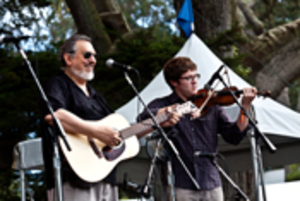He’s played with everyone, he’s toured everywhere, he can lead a raucous big band or hold an audience silent with a solo acoustic blues. Here’s the story of David Bromberg, or at least some of it . . . Born in Philadelphia in 1945 and raised in Tarrytown, NY, ‘as a kid I listened to rock ‘n’ roll and whatever else was on the radio,’ says Bromberg. ‘I discovered Pete Seeger and The Weavers and, through them, Reverend Gary Davis. I then discovered Big Bill Broonzy, who led me to Muddy Waters and the Chicago blues. This was more or less the same time I discovered Flatt and Scruggs, which led to Bill Monroe and Doc Watson.’ Bromberg began studying guitar-playing when he was 13 and eventually enrolled in Columbia University as a musicology major. The call of the Greenwich Village folk scene in the mid-’60s drew David to the downtown clubs and coffeehouses, where he could watch and learn from the best performers, including primary sources such as his inspiration and teacher, the Reverend Gary Davis. Bromberg’s sensitive and versatile approach to guitar-playing earned him jobs playing the Village ‘basket houses’ for tips, the occasional paying gig, and lots of employment as a backing musician for Tom Paxton, Jerry Jeff Walker and Rosalie Sorrels, among others. He became a first-call, ‘hired gun’ guitarist for recording sessions, ultimately playing on hundreds of records by artists including Bob Dylan (New Morning, Self Portrait, Dylan), Link Wray, The Eagles, Ringo Starr, Willie Nelson, and Carly Simon. An unexpected and wildly successful solo spot at the 1970 Isle of Wight Festival in Great Britain led to a solo deal with Columbia Records, for whom David recorded four albums. His eponymous 1971 debut not only included the mock-anguished ‘Suffer to Sing the Blues,’ a Bromberg original that became an FM radio staple, but also ‘The Holdup,’ a songwriting collaboration with former Beatle George Harrison, whom he met at his manager’s Thanksgiving dinner festivities. Harrison also played slide guitar on the track. Through Bromberg’s manager, Al Aronowitz, David also met the Grateful Dead and wound up with four of their members, including Jerry Garcia, playing on his next two albums. Bromberg’s range of material, based in the folk and blues idioms, continually expanded with each new album to encompass bluegrass, ragtime, country and ethnic music, and his touring band grew apace. By the mid-’70s, the David Bromberg Big Band included horn-players, a violinist, and several multi-instrumentalists, including David himself. Among the best-known Bromberg Band graduates: mandolinist Andy Statman, later a major figure in the Klezmer music movement in America, and fiddler Jay Ungar (who wrote the memorable ‘Ashokan Farewell’ for Ken Burns’ PBS documentary, ‘The Civil War’).






